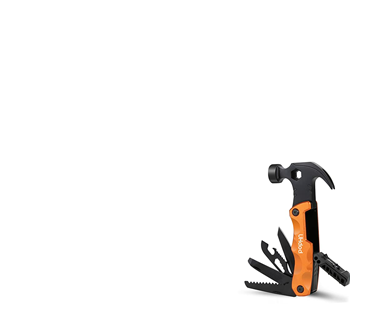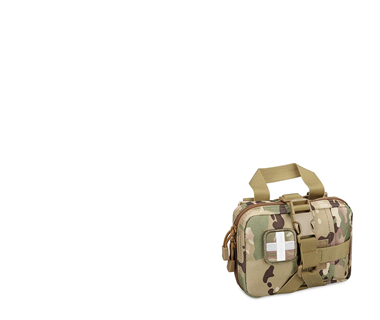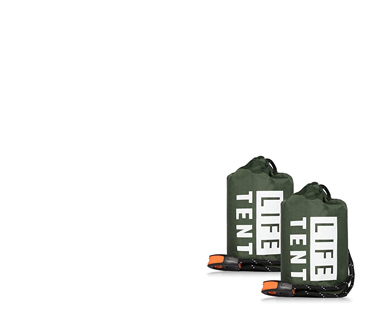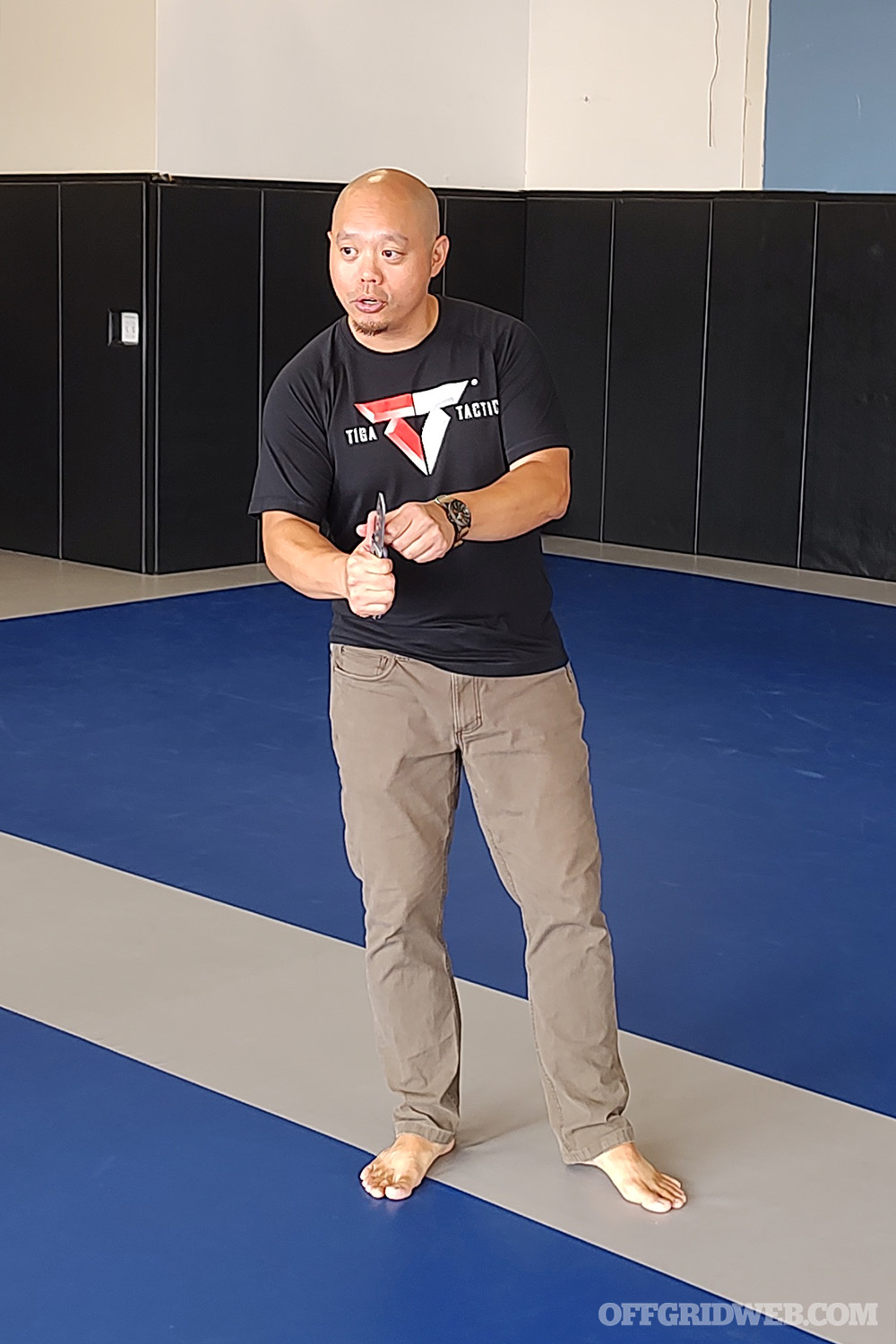Lessons Learned from Tiga Tactics’ Knife Defense Seminar Leave a comment
When most people think of knife fighting, their first thought likely goes to a Hollywood action movie. Sweaty, muscular men lunging and slashing at each other with large blades may be the cinematic depiction, but knife attacks are rarely so overt in nature. A blade often isn’t noticed in a fight until it has been used repeatedly — many victims of stabbings report that they believed they were being punched until they saw blood. Patrick Vuong and Dr. Conrad Bui have worked hard to teach students how to defend against attacks like these in their Tiga Tactics Knife Defense2 seminar (read as Knife Defense Squared). The instructor duo boasts over 60 combined years of martial arts experience, and formed their company to provide real-world self-defense training.
Knife Defense2 is a two-day seminar covering self-defense bare-handed against an attacker, as well as self-defense using a blade. The course brought in students with diverse ages, backgrounds, and martial arts experience levels. Despite these differences, the curriculum was simple enough for beginners and an excellent skills refresher for those with extensive martial arts backgrounds. But before any hands-on skills were taught, the first lesson provided was on defensive mindset.
Above: The co-founders of Tiga Tactics, Patrick Vuong (pictured here) and Conrad Bui, are both active contributors to Offgrid magazine and our sister publications Recoil and Concealment. Vuong and Bui have decades of experience with a variety of martial arts and edged weapons.
Tiga Tactics teaches defensive mindset in 3 parts: stay alert, stay humble, and stay kind. This involves avoiding fights rather than being drawn into them. When it comes to actual fighting, Tiga Tactics’ motto is simple: “Run if you can, destroy if you must.” Fights should be avoided at all costs but may be difficult to avoid at times. Students were shown footage of real-life knife attacks to reinforce how quick and deadly an attack with a knife can be. Basic empty-hand attacks of palm-strikes and eye-gouges, as well as elbow and knee strikes, were taught as simple combative techniques appropriate for all levels.
Above: A palm strike is a simple technique that can be devastating and disorienting when used effectively against an attacker.
Next, the lesson moved into knife defense. Tiga Tactics knife defense relies on concepts summarized by the acronym PRO: Protect, Reposition, and Offense. The purpose of this defense is to close the distance while blocking the attack, gain control of the knife, and deal damage in an appropriate manner. The Tiga Tactics team taught students how to defend against what they deemed to be the two most common knife attack movements. These are the overhand, downward angled “Psycho” stab (named after the classic 1960s horror film), and the upward thrust. When attempting to stab, attackers often repeatedly thrust at their victims in a sewing machine manner. After the initial block, the idea is to close distance as the attacker retracts the knife to stab again. This allows the would-be victim to gain more control over the encounter.
Above: The upward thrust is one of the most common knife attack techniques used by criminals. Tiga Tactics teaches a crossed-arm block to intercept this type of attack, as demonstrated here by Vuong.
On the second day, the lesson went into carrying knives and using them for self-defense. As with handguns, the location the blade is carried on the body matters. For the sake of speed and ambidextrous drawing, carrying a knife in the appendix position is an excellent option.
Although the Tiga Tactics team made it clear that fixed-blade knives were ideal for fighting, local laws and convenience leads many people to choose a folding knife as their daily carry. The downside of folders is the slower draw and less secure mechanism for fighting. With knife fighting, the tactics are nearly the opposite of an empty-handed defense. Space from the attacker is needed to allow for the knife to be deployed. Acquiring solid purchase on the knife while pushing the adversary’s face away provides for a better draw, and reduces the risk of the attacker snatching the blade during the draw stroke.
Above: Tiga Tactics’ Protect, Reposition, and Offense (PRO) sequence teaches students how to spot and guard against an initial attack, reposition to gain control of a weapon, and finally deal damage to end the threat.
The class spent over an hour learning and practicing the knife draw from a pocket. Many students found the draw to be inconsistent at best with a folding knife. As they progressed, a shot timer was introduced to challenge and encourage students to draw faster. To build on blade combatives, a variation of Filipino Martial Arts angled cuts was introduced and practiced. The final exercise had students defend and counterattack against each other in rapid succession. Afterwards, there was an open discussion on use of force and the legality of using a weapon in a fight.
Although edged weapon combatives is a subject that can take years or even decades of constant practice to truly master, this class provided a great introduction to the basics of this complex skill set. We certainly hope we never find ourselves facing a knife attack, but if we do, we’ll feel a little more confident after learning a few of Tiga Tactics’ methods to escape, block, or even counter the attacker. For more information on future Tiga Tactics classes and seminars, go to TigaTactics.com.
Related Posts
Lessons from a Soviet Union Collapse & Chernobyl SurvivorAfter living through the collapse of the Soviet Union and the fallout of Chernobyl, Greg Mihovich understands the value of preparedness.Bag Drop: Viktos Upscale 2 Urban EDC Sling BagThis Viktos Upscale 2 sling bag belongs to one of our female freelance photographers, who wears it instead of carrying a traditional purse.Video: RECOIL Staff at Finnish Brutality 2022Iain Harrison, the Editor of RECOIL, flew into Helsinki to participate in Varusteleka’s Finnish Brutality 2022 competition.Interview: John Correia of Active Self Protection (ASP)Active Self Protection channel owner John Correia narrates and discusses videos of real-life violent encounters from across the world.Smooth Moves: The Full Spectrum Warrior Combat Mobility SystemThe Full Spectrum Warrior course taught us a better appreciation for how the human body moves and new variations on shooting techniques.Preps of the Pros: Contributing Writer Patrick Diedrich’s EDC Gear & Go BagMy approach to EDC gear is “versatile redundancy.” Every item carried should have more than one function and should complement each other.Preps of the Pros: OFFGRID Editor Tom Marshall’s EDC Gear & Go BagDefend, Move, Communicate, Medicate — your EDC gear should enable you to protect yourself, navigate, call for help, and treat injuries.Video: ProjectFarm’s Best Folding Knife TestsProject Farm recently put together a two-part “Best Folding Knives” video series that tests 30 folders from $5 all the way to nearly $400.Behind the Blade: Interviews with Four Knife DesignersWe spoke to four knife designers about why they devised their blades in the first place, as well as how they’ve changed over time.
The post Lessons Learned from Tiga Tactics’ Knife Defense Seminar appeared first on RECOIL OFFGRID.




